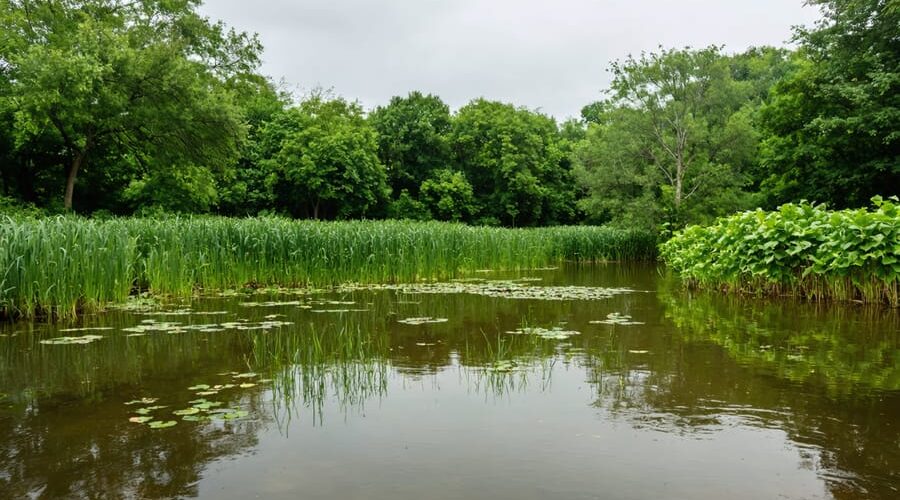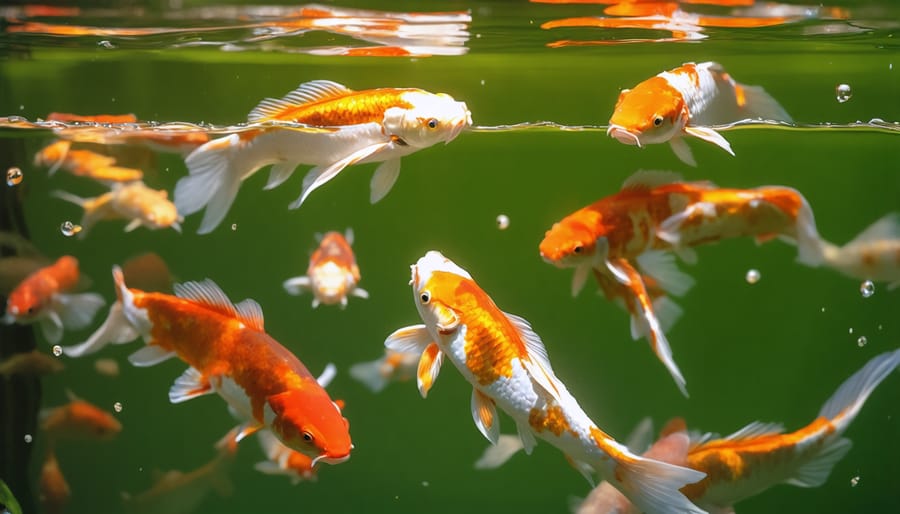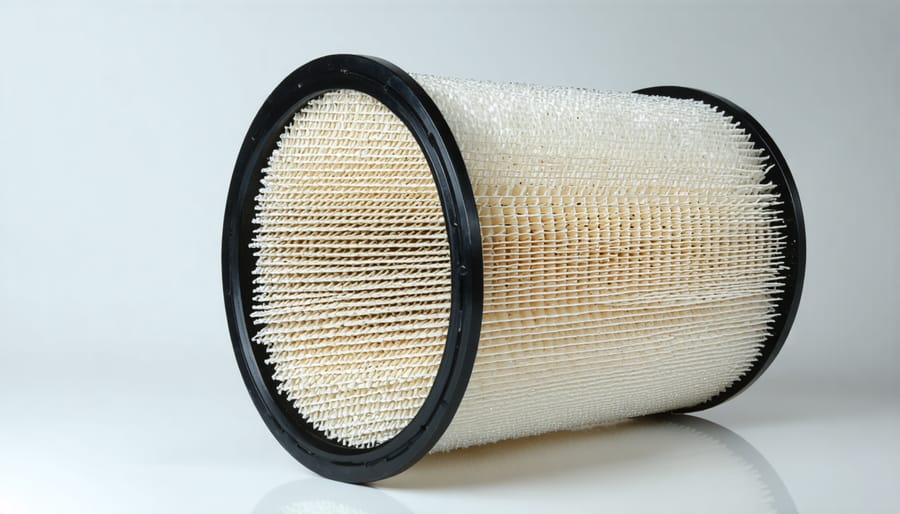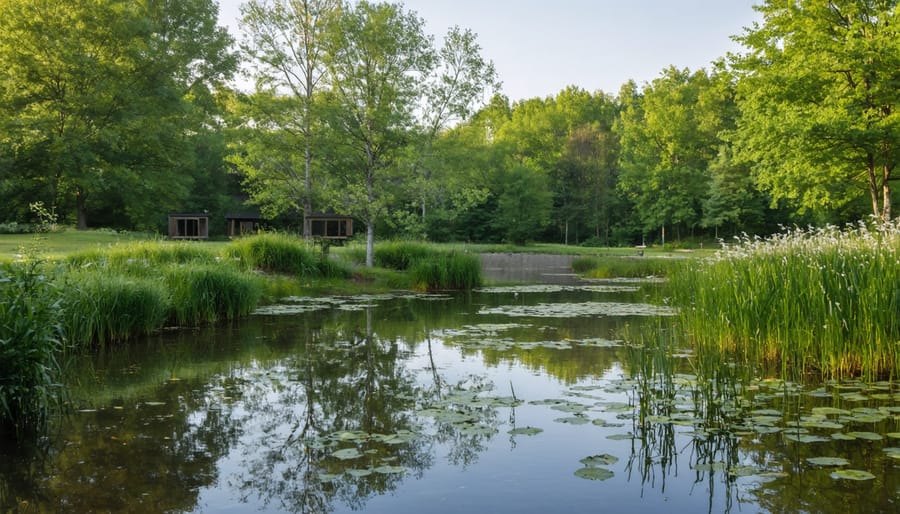
Advanced Pond Filtration That Actually Works (And Why It Matters)
Transform your pond’s water quality with advanced filtration concepts that go beyond basic mechanical and biological processes. Modern filtration technology has evolved dramatically, offering pond owners powerful new ways to maintain crystal-clear water while supporting healthy aquatic ecosystems.
Whether you’re battling persistent algae issues or seeking to upgrade an existing system, understanding advanced filtration opens up exciting possibilities for your water feature. From cutting-edge UV clarification to innovative bio-media that hosts beneficial bacteria colonies, today’s filtration solutions combine time-tested principles with breakthrough engineering.
In this comprehensive guide, we’ll explore how advanced filtration systems work synergistically to create optimal water conditions. You’ll discover how moving bed filters maximize biological filtration efficiency, learn about the latest developments in mechanical pre-filtering, and understand how to integrate multiple filtration stages for professional-grade results.
Perfect for both DIY enthusiasts and experienced pond keepers, these advanced concepts will help you make informed decisions about upgrading your system. We’ll break down complex processes into practical, actionable steps while focusing on cost-effective solutions that deliver noticeable improvements in water clarity and quality.
Get ready to take your pond’s filtration to the next level with proven techniques that work in real-world applications.
Why Traditional Filters Fall Short
Common Filtration Pitfalls
Even experienced pond owners can stumble into common filtration challenges that affect water quality. One frequent mistake is undersizing external filtration systems, leading to inadequate water processing and cloudy conditions. Another pitfall is irregular maintenance schedules, where filter media becomes clogged and loses effectiveness.
Many pond enthusiasts overlook the importance of proper flow rates, installing pumps that are either too powerful or too weak for their setup. This mismatch can create dead zones where debris accumulates or cause excessive turbulence that stresses fish. Seasonal changes often catch pond owners off guard too – what works in summer might not be sufficient during fall when leaves increase the bioload.
Perhaps the most common mistake is relying solely on mechanical filtration while neglecting biological filtration needs. This oversight can lead to persistent algae problems and unstable water parameters. Remember, successful filtration is about finding the right balance for your specific pond’s ecosystem.
The Hidden Costs of Poor Filtration
Poor filtration might seem like a minor issue at first, but its effects can ripple through your entire pond ecosystem. Beyond just cloudy water, inadequate filtration creates a cascade of hidden costs that affect both your pond’s health and your wallet. When it comes to maintaining healthy fish, proper filtration is absolutely essential.
Think of your pond’s filter as its kidneys – when they’re not working properly, toxins build up quickly. Fish become stressed and more susceptible to disease, leading to costly medications and potential losses. Poor filtration also means you’ll spend more time cleaning your pond, sometimes up to several hours each week, scraping algae and removing debris that a proper filter would handle automatically.
The impact on water clarity isn’t just aesthetic – reduced visibility makes it harder to spot potential problems with your fish early on. Plus, constantly running inefficient equipment often leads to higher energy bills. By investing in quality filtration now, you’ll save countless hours of maintenance and create a healthier environment for your aquatic friends.

Modern Mechanical Filtration Technologies
Multi-Stage Filtration Systems
Today’s pond enthusiasts are discovering the incredible benefits of multi-stage filtration systems, which combine different filtering methods to create crystal-clear water. Think of it as a series of specialized cleaning stations, each designed to tackle specific water quality issues.
These modern systems typically start with mechanical filtration, using foam or mesh to catch larger debris like leaves and twigs. Next comes biological filtration, where beneficial bacteria break down harmful substances in specially designed media. Many systems then incorporate chemical filtration using activated carbon or zeolite to remove dissolved pollutants and clarify the water.
What makes these systems so effective is how each stage builds upon the previous one. For example, mechanical filtration prevents debris from clogging biological media, while chemical filtration polishes the water after biological processes have done their work. Some advanced systems even include UV clarification as a final stage to control algae growth.
The beauty of modern multi-stage systems is their flexibility. You can customize each stage based on your pond’s specific needs, whether you’re dealing with heavy fish loads, excess nutrients, or seasonal challenges. Plus, these systems are often designed with easy maintenance in mind, featuring quick-release valves and accessible filter media.
For the best results, consider starting with a three-stage system and adding components as needed. This approach allows you to fine-tune your filtration while keeping maintenance manageable.
Vortex and Settlement Chambers
Vortex and settlement chambers are game-changers when it comes to pre-filtering your pond water, and they’re simpler than they sound! Think of them as your pond’s first line of defense, catching leaves, twigs, and other debris before they can clog up your main filtration system.
A vortex chamber works by creating a spinning motion in the water, similar to a mini whirlpool. As water swirls around, heavier particles like sand and sludge get pulled down to the bottom by gravity, while lighter, cleaner water continues through your filtration system. It’s like having a self-sorting system that does the heavy lifting for you!
Settlement chambers, on the other hand, slow down the water flow, giving particles time to sink to the bottom naturally. Picture a peaceful river delta where sediment settles in the calm waters – that’s exactly what’s happening in your settlement chamber.
The best part? These systems are relatively low-maintenance. Most have convenient drain valves at the bottom, making it easy to flush out collected debris. You’ll typically only need to clean them every few weeks, depending on your pond’s debris load.
For optimal results, consider installing both types in sequence – the vortex chamber first, followed by the settlement chamber. This duo can remove up to 80% of solid waste before water even reaches your biological filter!
High-Flow Mechanical Filters
High-flow mechanical filters represent an exciting leap forward in pond filtration technology, offering powerful cleaning capabilities while maintaining excellent water flow rates. These modern systems use advanced screening materials and innovative design features to trap debris without creating the dreaded bottleneck effect that plagues many traditional filters.
The secret lies in their larger surface area and specially designed filter media that allow water to pass through efficiently while capturing particles as small as 30 microns. Many new models feature self-cleaning mechanisms that automatically flush out collected debris, reducing maintenance time significantly.
One popular innovation is the drum filter design, which uses a rotating screen that continuously cleans itself as it turns. As debris builds up on the screen, a sensor triggers a backwash cycle that sprays the collected waste into a separate chamber, keeping the main filter area clean and maintaining optimal flow rates.
Another breakthrough is the development of hybrid mechanical filters that combine multiple filtration stages in a single unit. These systems often incorporate settling chambers, mechanical screening, and even biological filtration zones, all while maintaining high flow rates that keep your pond water crystal clear.
For DIY enthusiasts, many of these systems now come with user-friendly features like clear viewing windows to monitor debris buildup and easy-access panels for maintenance. Some models even connect to smartphone apps, allowing you to monitor filter performance from anywhere.

Optimizing Your Filtration System
Sizing and Selection
Choosing the right filtration capacity for your pond is crucial for maintaining crystal-clear water and healthy aquatic life. Start by calculating your pond’s total volume in gallons (length x width x average depth x 7.48). As a general rule, your filtration system should be able to process your pond’s entire volume at least once every two hours.
For fish ponds, consider the fish load – a good guideline is one inch of fish per 10 gallons of water. Heavy fish stocks require more powerful filtration. If you’re keeping koi, you’ll need even more robust filtering capacity, typically processing the entire pond volume once per hour.
Climate plays a role too. Warmer regions need stronger filtration as higher temperatures accelerate debris decomposition and algae growth. Consider seasonal changes – falling leaves in autumn demand extra filtering power.
Don’t forget to factor in other features like waterfalls or fountains. These additions increase the need for filtration as they introduce more oxygen and movement, which can stir up debris.
When in doubt, it’s better to oversize your filtration system slightly. While this might cost more initially, it provides a safety margin and often requires less maintenance. Just remember that bigger isn’t always better – an oversized system can be inefficient and waste energy.
Test your water quality regularly after installation to ensure your chosen system is meeting your pond’s specific needs.
Smart Placement and Flow Patterns
The secret to effective pond filtration isn’t just about having the right equipment – it’s about smart placement and creating optimal flow patterns. Think of your pond as a river system; water should move smoothly without creating dead zones where debris can accumulate.
For mechanical filters, position them where they’ll catch debris before it sinks to the bottom. Usually, this means placing them near surface skimmers or in areas where leaves and floating matter naturally collect. If you’re using a waterfall or stream, integrate the filter system at the top to maximize oxygenation as water cascades down.
Biological filters work best when placed after mechanical filtration, allowing beneficial bacteria to process only the finest particles. Create a circulation pattern that ensures water passes through both types of filtration before returning to the pond. A good rule of thumb is to position returns so they create a gentle circular motion, pushing debris toward your skimmer or pump intake.
Consider seasonal changes too. In summer, position returns to create surface movement for better oxygen exchange. During winter, adjust flow to maintain a quiet zone where fish can rest undisturbed. Remember that pumps should move your total pond volume at least once every two hours for optimal filtration.
Test your flow patterns by adding a small amount of dye to the water – this will reveal any dead spots that need addressing. Small adjustments in placement can make a big difference in your pond’s overall health and clarity.

Maintenance Made Easy
Keeping your advanced filtration system in top shape doesn’t have to be complicated. By following these essential maintenance practices, you can ensure your system runs efficiently year-round.
Start with a weekly visual inspection of your filter components. Look for any obvious signs of clogging, unusual noises, or decreased water flow. Clean your pre-filter or skimmer basket regularly – this simple task prevents larger debris from reaching your main filtration system.
Every month, check your filter media and give it a gentle rinse in pond water, never tap water, to preserve beneficial bacteria. If you’re using a UV clarifier, mark your calendar to replace the bulb annually, even if it’s still working, as its effectiveness diminishes over time.
For mechanical filters, backwashing should be performed when you notice reduced flow rates. Biological filter media should only be cleaned when absolutely necessary to maintain your beneficial bacteria colony.
Remember to inspect all connections and seals quarterly, tightening any loose fittings and replacing worn gaskets. During winter, adjust your maintenance routine according to your climate – some systems may need special attention during freezing weather.
Keep a maintenance log to track cleaning schedules and part replacements. This simple habit helps you stay on top of routine tasks and spot potential issues before they become problems.
As we wrap up our journey through advanced filtration concepts, remember that creating the perfect pond environment is both an art and a science. The key to success lies in understanding how different filtration methods work together and choosing the right combination for your specific needs. Whether you’ve decided to upgrade to a moving bed filter, implement a multi-stage system, or incorporate cutting-edge UV technology, each step you take brings you closer to achieving crystal-clear water and a thriving ecosystem.
Don’t feel overwhelmed by the variety of options available. Start with the basics we’ve discussed and gradually implement more advanced solutions as you become comfortable with your system. Pay attention to how your pond responds to changes, and keep a maintenance log to track improvements. Remember that even small adjustments can make a significant difference in water quality.
The most successful pond owners are those who remain curious and adaptable. As filtration technology continues to evolve, stay informed about new developments and be willing to experiment with different approaches. However, always prioritize the basics: proper sizing, regular maintenance, and balanced biological filtration remain the foundation of any effective system.
Consider joining local pond enthusiast groups or online communities where you can share experiences and learn from others. These connections can provide valuable insights and support as you implement new filtration strategies. Don’t be afraid to ask questions or share your own successes and challenges.
Take action today by evaluating your current setup and identifying one area where you can apply these advanced concepts. Whether it’s adding a pre-filter to reduce maintenance, upgrading your biological media, or installing an automated monitoring system, each improvement brings you closer to your ideal pond environment. Remember, the perfect filtration system isn’t built in a day – it’s developed through careful planning, observation, and continuous refinement.
